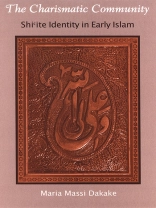The Charismatic Community examines the rise and development of Shiite religious identity in early Islamic history, analyzing the complex historical and intellectual processes that shaped the sense of individual and communal religious vocation. The book reveals the profound and continually evolving connection between the spiritual ideals of the Shiite movement and the practical processes of community formation. Author Maria Massi Dakake traces the Quranic origins and early religious connotations of the concept of walayah and the role it played in shaping the sense of communal solidarity among followers of the first Shiite Imam, Ali b. Abi Talib. Dakake argues that walayah pertains not only to the charisma of the Shiite leadership and devotion to them, but also to solidarity and loyalty among the members of the community itself. She also looks at the ways in which doctrinal developments reflected and served the practical needs of the Shiite community, the establishment of identifiable boundaries and minimum requirements of communal membership, the meaning of women’s affiliation and identification with the Shiite movement, and Shiite efforts to engender a more normative and less confrontational attitude toward the non-Shiite Muslim community.
विषयसूची
Acknowledgments
List of Abbreviations
Author’s Notes
Introduction
Part I: The Principle of Walayah and the Origins of the Community
1. Walayah in the Islamic Tradition
2. The Ghadir Khumm Tradition: Walayah and the Spiritual Distinctions of Ali b. Abi Talib
3. Walayah, Authority, and Religious Community in the First Civil War
4. The Shiite Community in the Aftermath of the First Civil War
Part II: Walayah, Faith, and the Charismatic Nature of Shiite Identity
5. Walayah as the Essence of Religion: Theological Developments at the Turn of the Second Islamic Century
6. Membership in the Shiite Community and Salvation
7. Predestination and the Mythological Origins of Shiite Identity
8. The Charismatic Nature and Spiritual Distinction of the Shiites
Part III: Creating a Community within a Community
9. Shiites and Non-Shiites: The Distinction between Iman and Islam
10. Degrees of Faith: Establishing a Hierarchy within the Shiite Community
11. “Rarer than Red Sulfur”: Women’s Identity in Early Shiism
12. Perforated Boundaries: Establishing Two Codes of Conduct
Notes
Bibliography
Index
लेखक के बारे में
Maria Massi Dakake is Associate Professor of Religious Studies at George Mason University.







![का आवरण Brian Schrag & Julisa Rowe: Community Arts for God's Purposes [Chinese] 貼近神心意的社群藝術 का आवरण Brian Schrag & Julisa Rowe: Community Arts for God's Purposes [Chinese] 貼近神心意的社群藝術](https://static.worldofdigitals.com/thumb_webp/740/9781645083740.webp)




